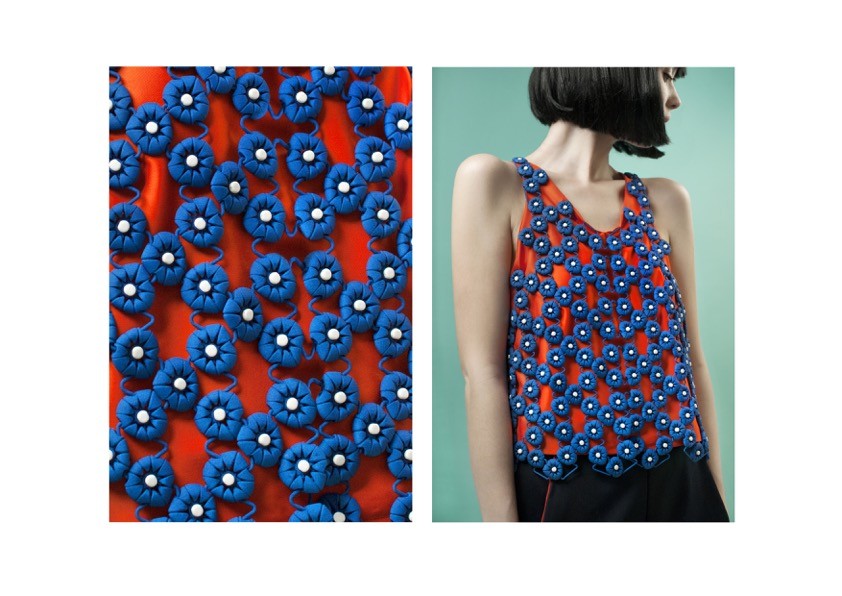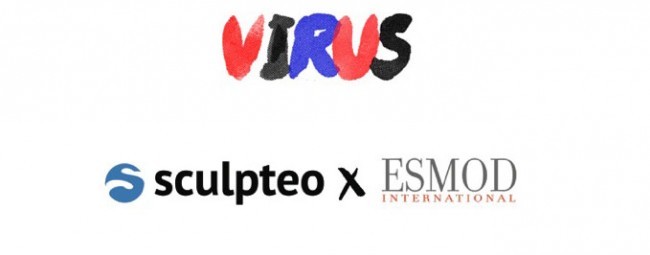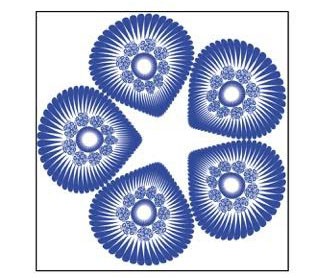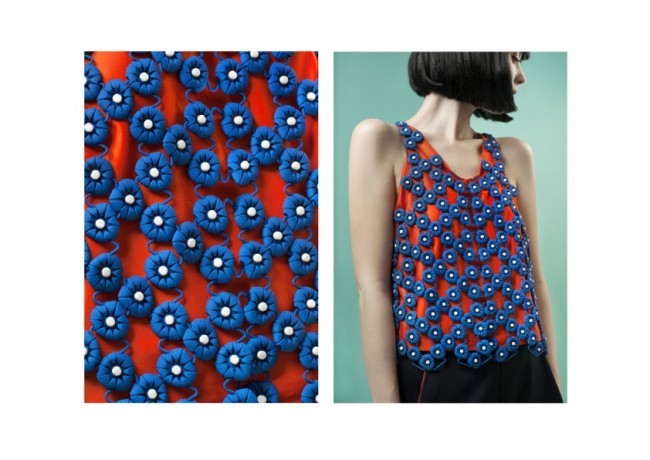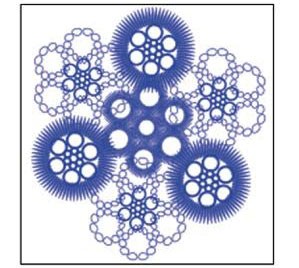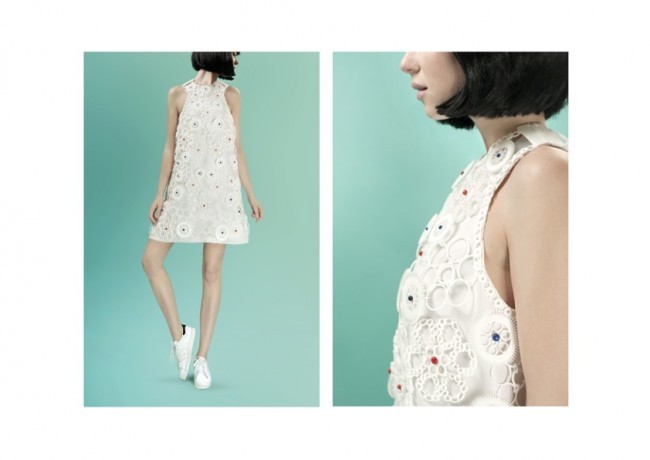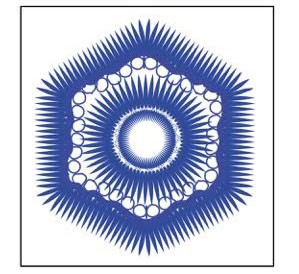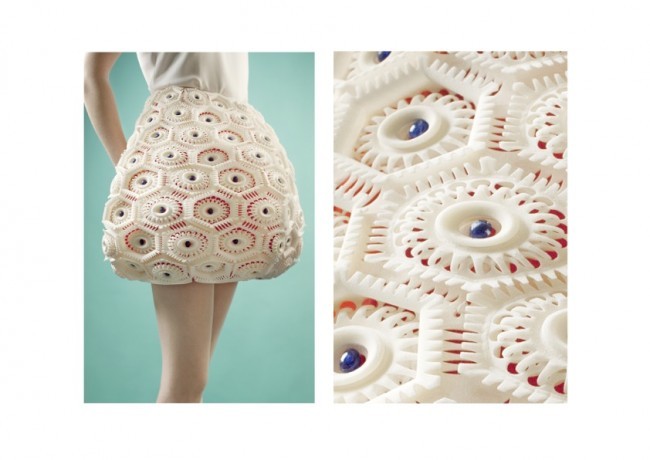The “Virus Collection”, your new line of 3D printed clothes
Posted By Claire Chabaud on Jan 6, 2016 | 0 comments
This year at CES 2016 we are excited to showcase our fashion collection called “Virus” designed by Anastasia Ruiz in partnership with the prestigious international fashion design school ESMOD.
As you probably already know 3D printing technology is spreading into many different industries, as the technology spreads it leaves new implementations, processes, and uses in its wake. We have no doubt that you’ve seen or heard about many of Sculpteo’s 3D printing projects and innovations in 2015, as we enter into 2016 we wanted to showcase the practical use of 3D printing technology with Sculpteo collaborative collection with ESMOD and Fashion Designer Anastasia Ruiz. Inspired by Anastasia Ruiz this collection is an example of elevating traditional fashion design by incorporating 3D Printing technology. We are very proud to unveil our collection at CES 2016.
During the collaboration with ESMOD, located in Paris, Fashion Designer Anastasia Ruiz worked with us to combine her vision for a dress, a skirt, and a top with our ability to make customized patterns and designs exactly the way that she envisioned.
Wisely Anastasia chose to retain a few traditional fashion manufacturing techniques such as using traditional fabric; however 3D printed customized patterns elevate the designs by adding architectural interest.
What resulted is the collaborative fashion collection that we are showcasing at CES 2016 in Las Vegas, NV.
The story behind Anastasia’s Fashion Tech or “FashTech” design
Anastasia’s focus for this collection was to create an example that proved 3D printing is not only for ‘haute-couture’, but that could be used off the catwalk as well. This is an idea we also believe in. There were however several challenges that we needed to overcome to create the “Virus” collection.
Finding the right 3D printed wearable material
For the Virus collection we used both our polyamide and our brand new material TPU, the most flexible on the market, with a flexibility of 65A Shores. The specific mechanical properties of these two different materials require that we create the mesh in two very different and unique ways. For the mesh 3D printed in Polyamide our attention was mainly on the joints, we focused on this section using that material for the purpose of creating articulated mesh. Whereas the mesh 3D printed in TPU needed to provide structure which enhances the flexibility of the material, as counterintuitive as that sounds. According to Anastasia the fashion design process is as follows: create the theme of the collection, and then look for the materials and fabric which match the vision. With 3D printing, the process is a bit different as I’m sure you can imagine the designer still creates their theme first, but because they are working in 3 dimensions they are free to add more architectural interest and really customize their designs not only with shapes but also with materials. In the “Virus” collection we decided to use 3D printing to create the embroidered pattern based on the exact vision that Anastasia had. To make you dive into the creation of the collection, we illustrate each piece with the very first pattern imagined by Anastasia, the first sample we 3D modelized from it and the final piece!
The first piece is a top with cells based on the following pattern.
At first Anastasia Ruiz put on paper her vision for each cell. Then she used Illustrator software to design the shape and replicate them to create a new form. From this first 2D representation, the collaboration with Sculpteo started. With the help of our 3D designer, Alvise Rizzo, we figured out a way to create a 3D model. As the flexibility is not one of the technical properties of the Polyamide we had to think how to create an articulated structure to make it follow the movement of the traditional fabric. Sculpteo’s team came up with the idea of triangular joints to make all the parts fully mobile but also to respect the vision of the fashion designer. Once we 3D printed the first sample of the design we worked with it as a classic fabric. We completed the iteration process until we had a sample that she thought was perfect. Once this step was done we 3D printed the model, died it in blue, and Anastasia affixed it to the fabric as if it was embroidered. Our collaborative goal for this design was to really highlight the possibilities of 3D printing by creating innovative articulations.
The second piece in the collection is a dress with a group of different virus cells 3D printed in polyamide.
By using the same process, our collaborative goal was to show how size and scale can be used in 3D printed fashion. When you look at the dress from the top to the bottom you can see the 3D design growing to better fit the shape of the dress and emphasize the flared bottom.
The third piece in the collection is a skirt with cells 3D printed in our brand new TPU material.
This skirt is very special to us. Indeed, this year for the CES 2016 we have announced the launch of our new material which is TPU, as we said earlier it is the most flexible on the market to date. So in this skirt, Anastasia Ruiz and Sculpteo’s team wanted to enhance the flexibility of the material and also display how the conception differs whether you want to 3D print in polyamide or TPU. For example with TPU we played with volume, and this proved to be a challenge due to flexibility of the material. To make the most of this flexible 3D printing material Anastasia decided to design a bubble skirt. Anastasia’s pattern allowed us to 3D model the cells on two levels to create a visual effect.
Each of these items in our collection showcase our new materials, and also the represent the possibilities of FashTech. Discover more about Anastasia Ruiz and the collection in this video and visit us at CES to discover these clothes in real !


 Connect with Google
Connect with Google Connect with Facebook
Connect with Facebook